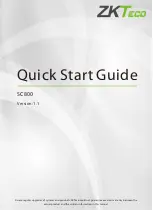
Cleaning Your cRIO-FRC and Installing Protective Gaskets
This document describes how to clean the cRIO-FRC if it has been internally contaminated by metallic
debris such as wire fragments, flakes, or dust. You must be very careful disassembling the cRIO-FRC.
When you remove the printed circuit board (PCB) from the enclosure, it is vulnerable to electrostatic
discharge (ESD) and physical damage. Failure to follow the directions in this document may result in
damage to your cRIO-FRC and void the warranty.
If you are uncomfortable with disassembling and cleaning your controller, you can provide a minimal
level of protection by installing the external Module Connector Gasket. To do that, skip to the
Installing the Module Connector
Gasket
section of this document.
Table of Contents
•
Preparation
•
Disassembling the cRIO-FRC
•
Cleaning the cRIO-FRC
•
Installing the I/O Gasket
•
Reassembling the cRIO
•
Installing the Module Connector Gasket
Содержание cRIO-FRC
Страница 10: ......
































